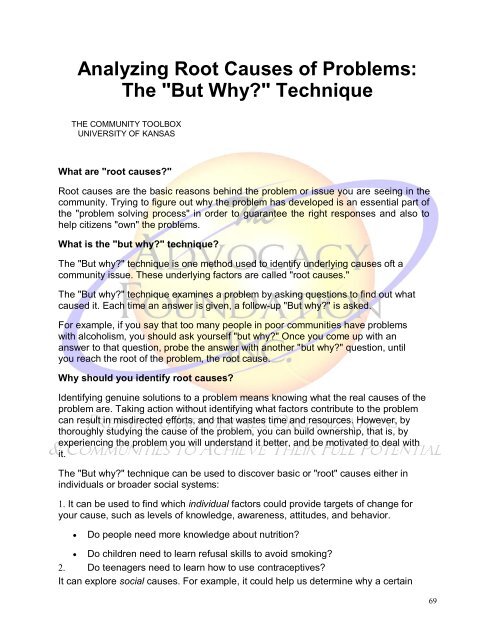Community Needs Assessment Process
Community Needs Assessment Process
Community Needs Assessment Process
You also want an ePaper? Increase the reach of your titles
YUMPU automatically turns print PDFs into web optimized ePapers that Google loves.
Analyzing Root Causes of Problems:<br />
The "But Why?" Technique<br />
THE COMMUNITY TOOLBOX<br />
UNIVERSITY OF KANSAS<br />
What are "root causes?"<br />
Root causes are the basic reasons behind the problem or issue you are seeing in the<br />
community. Trying to figure out why the problem has developed is an essential part of<br />
the "problem solving process" in order to guarantee the right responses and also to<br />
help citizens "own" the problems.<br />
What is the "but why?" technique?<br />
The "But why?" technique is one method used to identify underlying causes oft a<br />
community issue. These underlying factors are called "root causes."<br />
The "But why?" technique examines a problem by asking questions to find out what<br />
caused it. Each time an answer is given, a follow-up "But why?" is asked.<br />
For example, if you say that too many people in poor communities have problems<br />
with alcoholism, you should ask yourself "but why?" Once you come up with an<br />
answer to that question, probe the answer with another "but why?" question, until<br />
you reach the root of the problem, the root cause.<br />
Why should you identify root causes?<br />
Identifying genuine solutions to a problem means knowing what the real causes of the<br />
problem are. Taking action without identifying what factors contribute to the problem<br />
can result in misdirected efforts, and that wastes time and resources. However, by<br />
thoroughly studying the cause of the problem, you can build ownership, that is, by<br />
experiencing the problem you will understand it better, and be motivated to deal with<br />
it.<br />
The "But why?" technique can be used to discover basic or "root" causes either in<br />
individuals or broader social systems:<br />
1. It can be used to find which individual factors could provide targets of change for<br />
your cause, such as levels of knowledge, awareness, attitudes, and behavior.<br />
<br />
Do people need more knowledge about nutrition?<br />
Do children need to learn refusal skills to avoid smoking?<br />
2. Do teenagers need to learn how to use contraceptives?<br />
It can explore social causes. For example, it could help us determine why a certain<br />
69

















